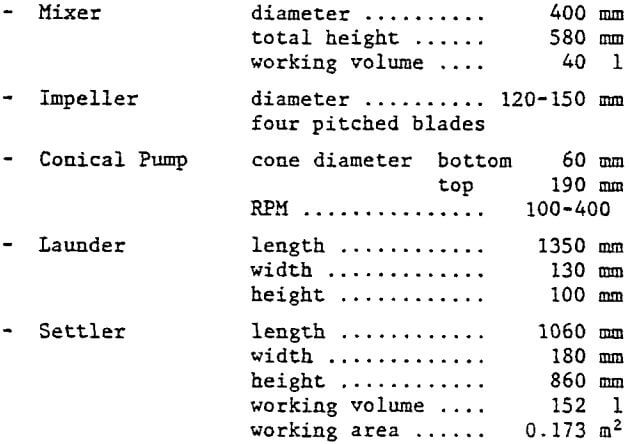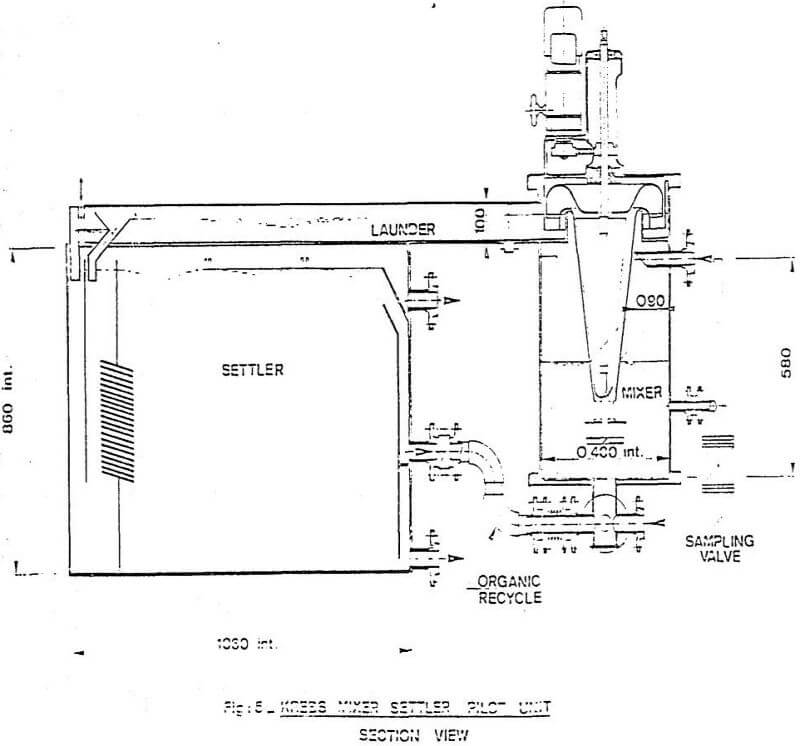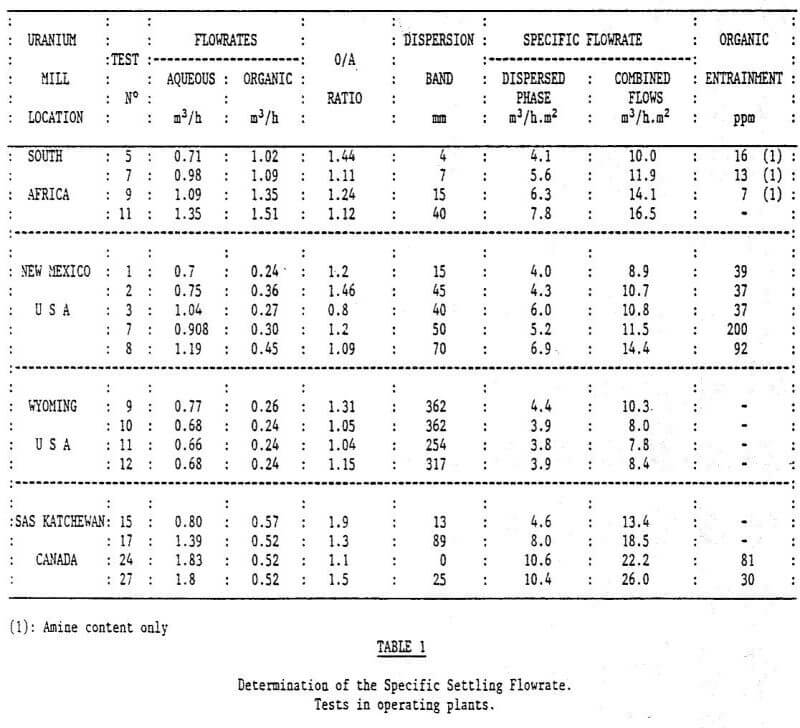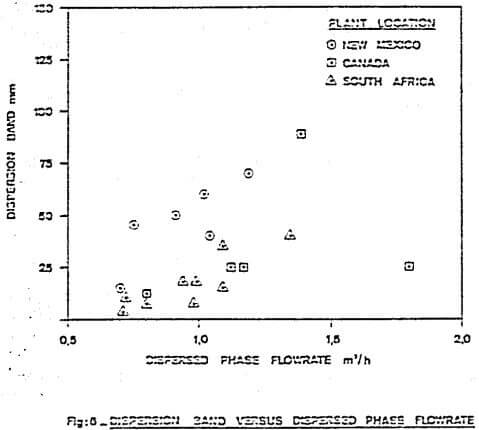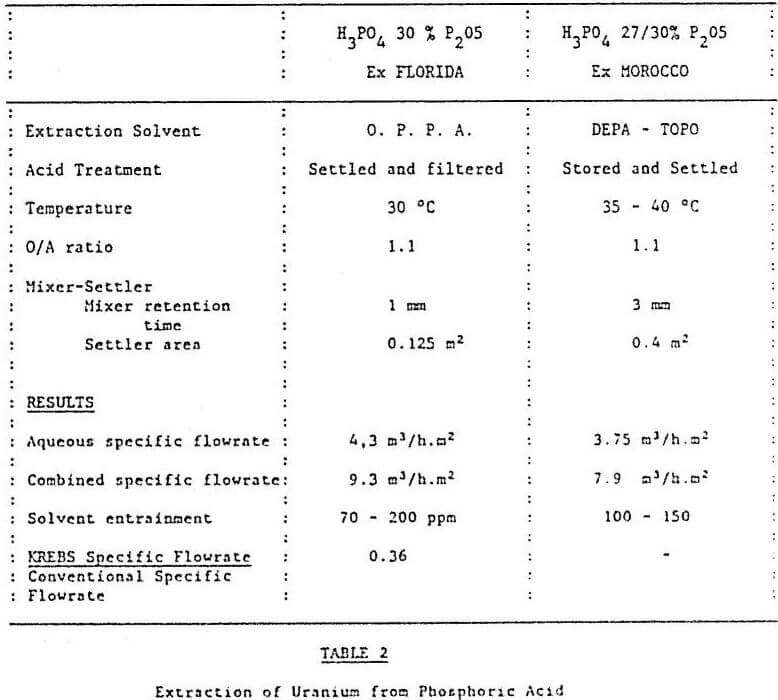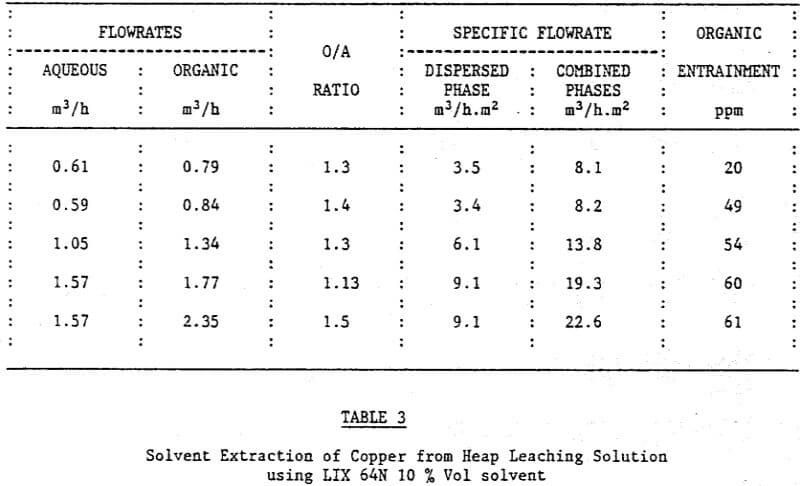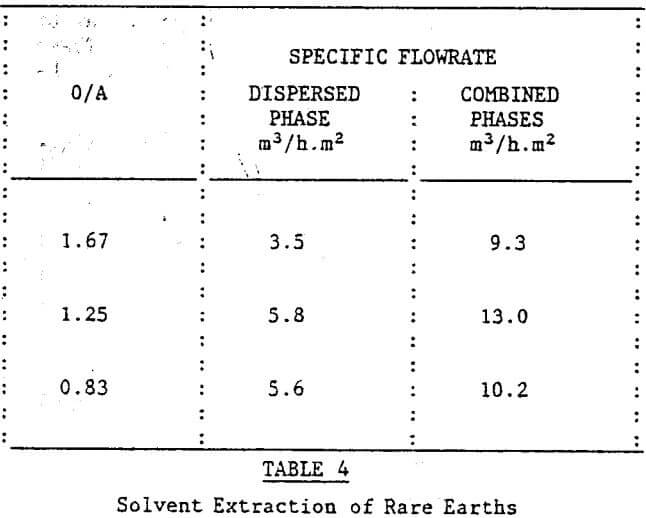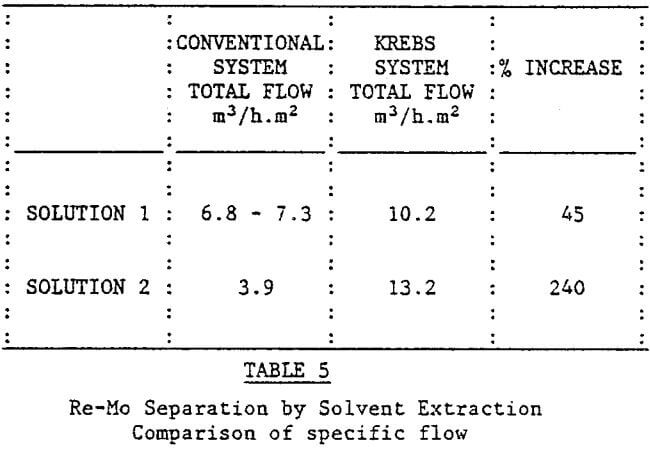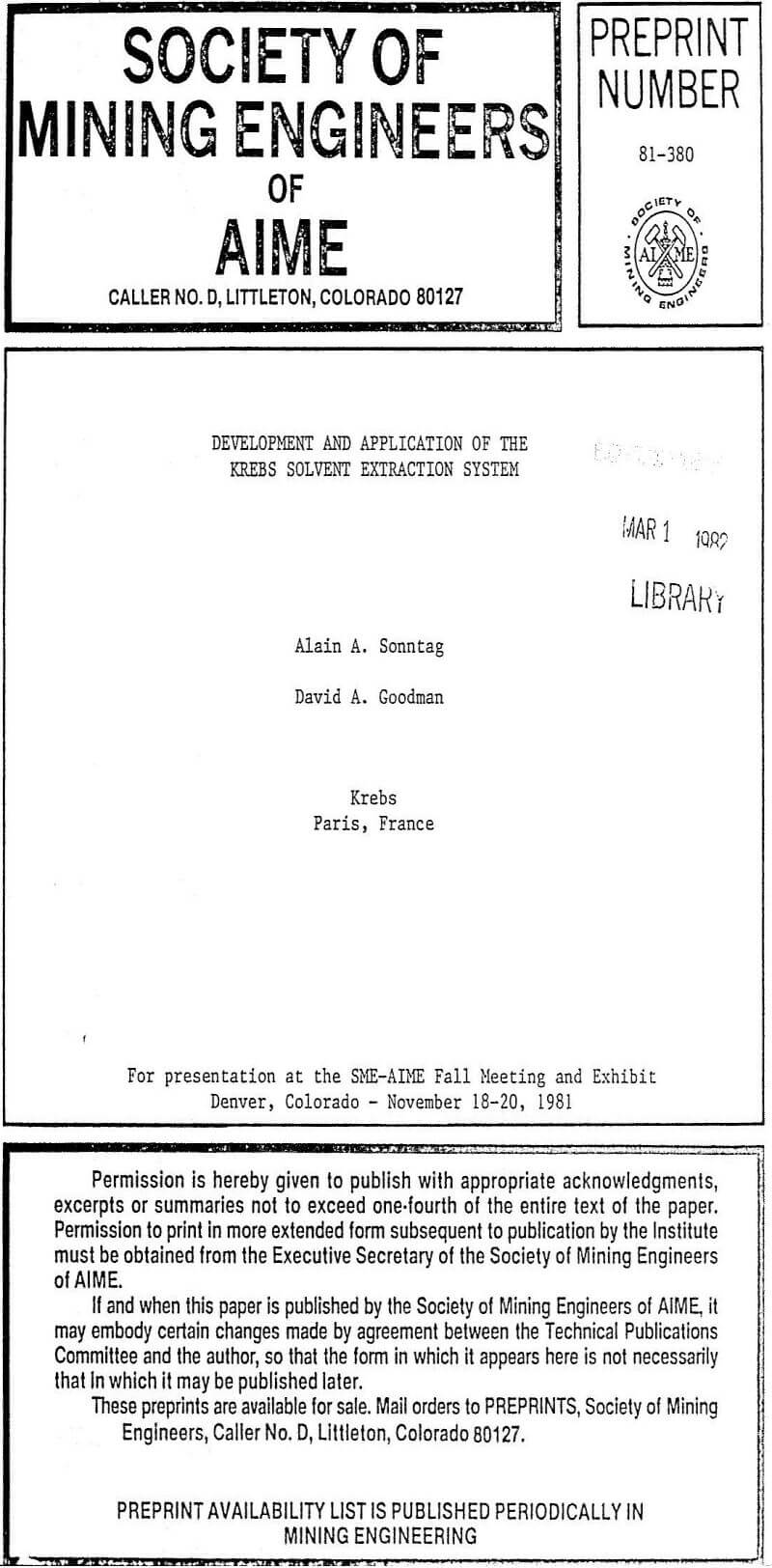The KREBS Mixer-Settler as shown on Fig. 1 includes the following features:
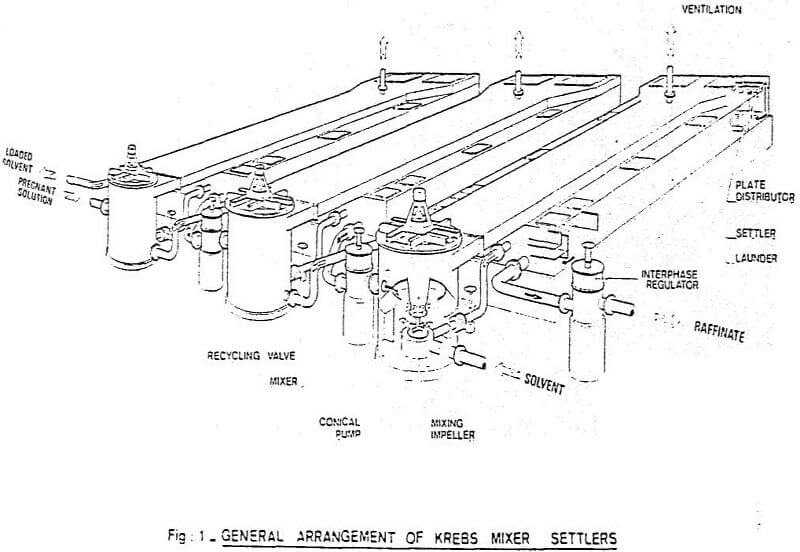
- A MIXING IMPELLER selected to best satisfy dispersion requirements.
- A low turbulence CONICAL PUMP, built around the impeller shaft, to transfer the dispersion from the mixer to the settler and induce phase separation.
- A SUPERPOSED LAUNDER provides further phase separation and makes it possible to simplify the layout of the equipment.
- A SETTLER of a simple design having a short angled plate distributor which directs the phases into the main part of the settler without turbulence and contributes to the phase disengagement. The settler itself is free of internals and provided with removable inspection covers for easy maintenance and cleaning.
- An INTERFACE REGULATOR used to adjust the height of the interface and to maintain the level of the liquid in the settler in case of plant shutdown or by-pass of a particular unit.
The mixer
The KREBS MIXER, as shown on Fig. 2 is an assembly of three main components:
- the mixing chamber with its internals,
- the rotor assembly composed of mixing impeller, conical pump rotor and drive mechanism,
- the conical pump stator and the discharge deflector.
The Mixing Chamber. The mixing chamber is designed for highest stage efficiency. Its volume and dimensions are defined to best satisfy process requirements such as phase flowrate and mass transfer rate. The chamber may be of cylindrical, rectangular or any intermediate shape.
The mixing chamber is fitted with anti-vortex baffles and the arrangement of the inlets is such that short-circuiting is avoided and stability of the continuous phase is assured.
Each mixing chamber is normally equipped with nozzles for sampling and instrumentation as required.
The Rotor Assembly. The rotor assembly is designed and constructed according to the mixing and pumping requirements of each individual system and is mounted on the vertical shaft.
The Mixing Impeller. The shape, dimensions and rotation speed of the mixing impeller are selected to obtain the optimum droplet size in the dispersion of one phase into the other.
Wherever possible, the characteristics of the impeller are defined by testing in a pilot unit and scaled up according to well established principles.
The Conical Pump Rotor. The conical pump rotor comprises the vertical shaft with radial trapezoidal blades attached to it. The size and the angle of the rotor blades are selected to achieve pumping of the total flowrate of the phases within the range of speeds chosen for mixing impeller.
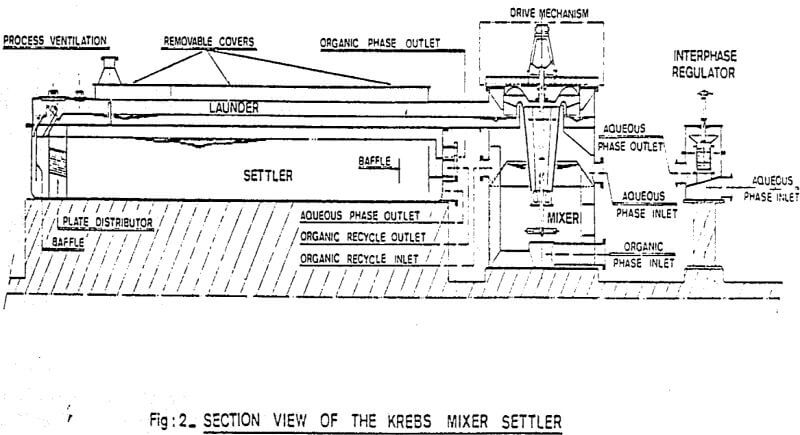
The rotor induces very little turbulence in the flow of the mixture and, due to the centrifugal forces developed, phase separation is induced in the conical pump itself. Moreover, the pumping curve is relatively flat and variations in the total flowrate of the feed solutions produce only slight changes in the height of the liquid level in the mixing chamber. The conical pump adjusts itself to the required “impeller diameter”, for a fixed speed of rotation (Fig. 3).
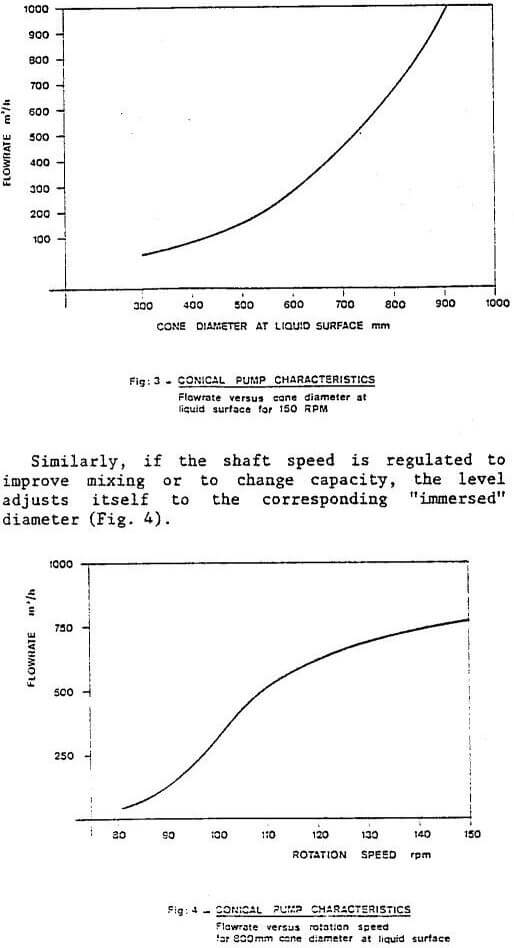
The clearance between the rotor blades and the frustum conical stator is kept large enough to avoid expensive tooling of the pump components.
The Drive Mechanism. The drive mechanism supports the rotor assembly and provides the required power for mixing and pumping. The KREBS Mixer can be equipped for infinite variations of impeller speed via hydraulic drive mounted on the supporting heap ring box or for fixed impeller speed via fixed speed electrical motor with appropriate reducer.
The Pump Stator. The pump stator is an upwards flared, stationary, hollow cone, which is at a fixed location in the mixing chamber. The mixture enters at the bottom of the cone and is “centrifuged” by the pump blades towards the top of the stator. During its rise, the centrifugal forces induce the phase separation which is continued in the launder connecting the mixer to the settler.
The upper portion of the stator is curved to allow smooth flow of the solution into the launder. This discharge deflector prevents possible spraying. It covers the entire stator and rotor of the conical pump.
An entry deflector is fixed at the bottom of the conical stator, thus preventing direct flow of fine mixture from the impeller to the pump stator and forces radial entry of the mixture.
The Settler
The partially separated phases leaving the conical pump are fed into a wide launder which directs, the pump overflow towards the opposite end of the settler, and further enhances phase separation.
At the end of the launder, the light phase, which is mainly organic, is fed into the upper part of the settler by means of an overflow weir provided with down pipes. The heavy phase, which is mainly aqueous, is fed into the lower part of the settler, by means of an overflow weir.
The height of both overflow weirs can be adjusted to suit a wide range of flowrates.
The light and the heavy phases enter the settling tank through a short angled plate distributor which eliminates turbulence and helps to stabilize the interface throughout the settler.
The distributor is made of parallel plates which cover the entire width and about one third of the height of the tank.
The phases are progressively separated in convenetional manner but with much greater efficiency owing to the pre-separation which has occured in the conical pump and the launder. A dispersion band is formed in the middle zone of the settling tank. In order to hold back this band and to reduce entrainment of small droplets with the separated phases, a baffle plate is provided at the outlet end of the tank.
Three separate take-offs are provided at the end of the settler:
- The organic phase is fed to the next up-stream mixer.
- The aqueous phase is fed through the interface regulator to the next down-stream mixer.
- A recycle can be fed back to the mixer to ensure correct phase ratio in that stage, as required.
The settler as well as the superposed launder are provided with removable inspection covers to provide access for checking and cleaning.
Mixer-Settler Development
Initial Experimental Work on the Conical Pump. The design of a solvent extraction system requires that, as well as mixing two phases, relatively large volumes be pumped from stage to stage against low heads. Conventionally, these two functions are achieved by using pumper-mixer impellers. The design of such impellers is necessarily a compromise between a mixing impeller and a pumping impeller.
In 1968, KREBS was studying a particular system for which the compromise was found not to be entirely satisfactory. Therefore, a program was initiated to develop a new type of pump which would more efficiently pump large volumes against low heads.
Among the different pumps studied was the conical pump used by KREBS to transfer mercury in salt electrolysis cells. There are rather small pumps with a rotating cone impeller.
In 1968, a model pump was built in which the cone was the revolving part. Flows obtained were in the range of 1 m³/h but this model was abandonned due to poor power efficiency.
In 1969, a conical pump with a fixed cone and revolving blades was designed and tested. The results were very promising and complete hydraulic tests were undertaken and basic parameters studied.
A total flow of 2 to 2,5 m³/h was obtained with pump efficiency in the range of 30 to 35% for a head of 100 mm.
Nickel Pilot Plant. As a next step in the development conical pumps were integrated into three mixer- settlers of small industrial scale to study the purification of nickel chloride solution in a pilot plant. The successful operation of the pumps confirmed the expected performances. In addition the testwork provided useful information on the performance of settler (which was of conventional design), the mixing conditions and the chemistry of the process. The pump flowrates ranged from 12 m³/h to 32 m³/h for heads of 300 to 400 mm.
Based on these results, KREBS built a full size plant to treat nickel solutions and produce cobalt chloride, ferric chloride and nickel carbonate.
Uranium pilot plant. Shortly afterwards, KREBS became involved in uranium hydrometallurgy proceeding with a full program of solvent extraction tests using a new type of pilot plant mixer-settler. The design of this unit included for the first time the launder on the top of the settler. The unit had the following characteristics:
Mixer: Volume…………………………………..0.3 m³
Conical Pump: Flowrate………………………10 – 12.5 m³/h
Settler: Area………………………………………..0.75 m²
The mixer-settler was installed in an operating uranium mill in FRANCE (LANGOGNE plant), and was
operated for several months in parallel to the commercial solvent extraction circuit. As a matter of interest, the tests gave good settling rate figures for both organic continuous and aqueous continuous operating conditions. Extrapolation factors were calculated for the mixer size and the settler area. Coalescence aids such as “knit mesh” and picket fences were tested but the benefits gained from their use were minimal and the problem of cleaning when crud was present further obviated their use.
The results of this testing program were used in 1977 for the design of the LANGOGNE and MOUNANA KREBS SX Plants.
Testing of a Large Size Pump. To scale up the conical pump to the needs of the MOUNANA plant and other plants which required a range of 800 – 1,000 m³/h, a prototype was built in 1977. This pump was tested on a water tank and the hydraulic results gave the design parameters for the commercial units subsequently installed.
A latter scale-up of the conical pump was accomplished with the construction in 1979 of a 2000 m³/h pump. It was tested with water and the various parameters of flowrate, power consumption, head, RPM, geometry and pump efficiency were studied and determined.
Summary. As a result of 13 years of mixer-settler development, KREBS has now in its hand a very useful and efficient piece of equipment offering:
- A wide range of steady flowrates.
- Efficient pumping at low RPM.
- Simple construction and low cost.
